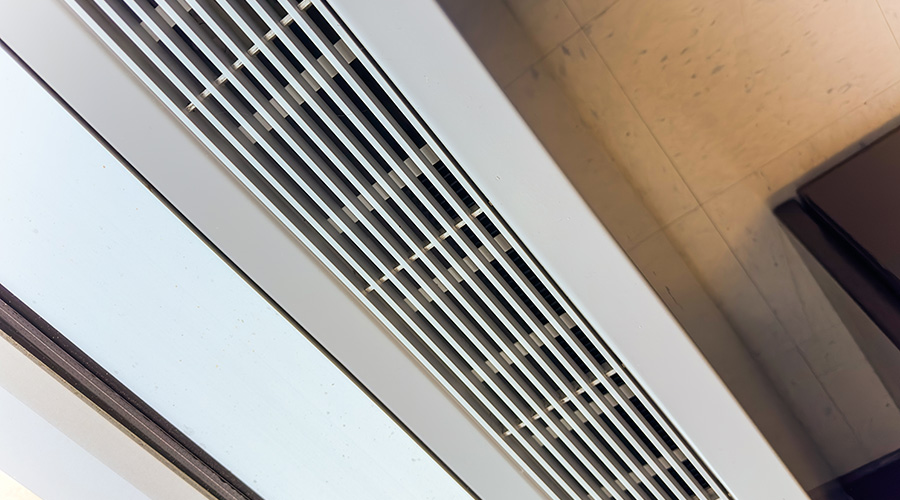The Humidity-Mold Link
Taking steps to control humidity levels can help managers prevent mold growth and improve the indoor environment
Concerns over building indoor air quality (IAQ) have focused the attention of maintenance and engineering managers on the need to control humidity levels in buildings. Although humidity levels have been ignored in the past, the recognition that high humidity levels can promote the growth of mold and other microorganisms in HVAC systems and on building surfaces has led to more widespread use of dehumidification systems.
Besides causing discoloration and odor problems, these microorganisms have been implicated as contributors to illness in building occupants. Typical symptoms include irritation to the eyes and throat, allergic reactions and asthma.
The Best Defense
Controlling building humidity is the best defense against the growth of mold and other microorganisms. Mold spores are present year round in most indoor and outdoor air. All they need to grow is four basic ingredients: organic nutrients, a surface on which to grow, darkness, and moisture.
All four of these ingredients can be readily found in buildings. Dirt, dust and many materials used in building construction provide the nutrients. HVAC ductwork, storage rooms and other locations not regularly illuminated provide the needed surfaces and darkness. Moisture is fostered by damp walls, leaks or improperly dehumidified building HVAC systems. Take away one of the ingredients, and mold will not flourish.
Of these ingredients, moisture is the easiest to control. Mold requires a humidity level of 40 percent or higher. Humidity levels below this figure significantly reduce the growth and spread of mold. Unfortunately, it is not uncommon to find humidity levels in building supply air of 70-90 percent in unregulated systems.
An Attack on Mold
Preventing the growth of mold in buildings requires first eliminating sources of moisture. If leaking roofs allow water to penetrate walls or ceiling tiles, then workers must eliminate leaks and repair or replace damaged materials. Similarly, workers must repair leaks from mechanical systems and piping and replace damaged building materials.
Inspections can ensure that building HVAC systems operate properly. Dirty coils reduce air flow and increase space humidity levels. Plugged or overflowing condensate pans provide a source of water that air can carry through the ductwork or that can simply overflow into occupied spaces. High internal-moisture loads can overpower building HVAC systems, particularly if those systems are undersized or not properly designed for the building loads.
Once the major sources of moisture have been eliminated, managers have two options for controlling space humidity levels: mechanical refrigeration systems and desiccant-based systems.
Mechanical Refrigeration Systems
Mechanical refrigeration systems provide dehumidification via condensation. They cool building air below its dew point, causing some airborne moisture to condense and drop out of the air stream. Air coming off a mechanical refrigeration cooling coil is at nearly 100 percent relative humidity, so before it can be supplied to the conditioned space, it must be heated slightly.
By varying the temperature of the air coming off the dehumidification system’s cooling coil and the amount of heating, systems can very accurately regulate relative humidity.
Mechanical refrigeration systems can be installed to work with a building’s HVAC system, regulating humidity levels in all areas served by a system. They also can be independent systems installed to regulate humidity levels in a particular area. Independent systems require no modifications to an existing HVAC system. All they require is a source for electricity and a plumbing connection to remove condensate from the system.
Mechanical refrigeration systems have several advantages. They offer relatively low first cost. They require very little space to install — typically, a coil and bypass dampers in an HVAC system's ductwork and a condensing unit located outside the building. They provide very accurate control of humidity within a building. And they are simple to operate and are very reliable.
The single biggest drawback to mechanical refrigeration system for humidity control is their operating cost. Energy required to cool the air temperature sufficiently to remove moisture can be costly, particularly in humid climates.
Desiccant-based Systems
Although mechanical refrigeration systems have long dominated the market for dehumidification systems, an alternative — the desiccant-based system — has become increasingly popular. Once considered unreliable and difficult to maintain, today's generation of desiccant-based systems offer managers an alternative to the mechanical refrigeration system for humidity control.
Desiccant-based systems use a slowly rotating wheel, drum or disk coated with an absorbent. As air from a building’s HVAC supply passes over one side of the wheel, the desiccant absorbs moisture. As the wheel rotates, it passes through a heated air stream.
Heated air passing over the desiccant picks up moisture and exhausts it from the building, at the same time recharging the desiccant. Energy to heat the air flow can come from natural gas or a waste heat source within a building.
Desiccant-based systems offer several advantages over mechanical refrigeration systems. The former operate on natural gas or waste heat rather than electricity, as is used by the latter. The use of electricity by mechanical systems tends to occur when cooling energy use and electricity costs are highest. Since the systems use a desiccant, rather than mechanical compression, to remove moisture from building air, their energy costs are much lower.
Another advantage of desiccant-based systems is their ability to dehumidify under changing loads and operating conditions. Mechanical refrigeration systems impact both building sensible and latent loads. Their design is a tradeoff between handling peak-sensible loads and large volumes of moisture from outdoor air.
If a system is too small, humidity will not be properly regulated. If a system is too large, first costs and operating costs increase. In contrast, desiccant-based systems impact only the moisture content of the cooling load. As a result, the systems can be sized to reduce both initial and operating costs, while providing well-regulated control over building relative-humidity levels.
Size is the biggest disadvantage of desiccant-based systems. In particular, systems that use a wheel tend to be rather large. Sufficient space must be available near an air-handling unit for the wheel to be installed. Managers also must dedicate additional space to the heated exhaust-air stream used to regenerate the wheel.
Guidelines for Selection
Selecting the system that is best suited for a particular application depends to a great extent on the conditions found in that facility. New construction allows the HVAC systems to be designed to include a particular type of dehumidification system. In older facilities, dehumidification system will have to be designed around the facility and its HVAC systems.
If humidity control problems are isolated to one or a small number of areas in a building, consider installing a stand-alone, mechanical refrigeration system. These units are low in first cost, easy to install, require little maintenance, and provide good humidity control for isolated areas within a building. Similarly, these units can be used effectively to reduce space humidity levels in areas that have been damaged by leaks or flooding. Fully portable, they can be temporarily installed where needed.
If humidity control is required for an entire building or for all areas served by a particular air handler, then dehumidification systems that are designed to work with the building's HVAC system are more cost-effective and more practical than stand-alone systems. The choice then becomes one of mechanical refrigeration or desiccant systems. Ultimately, that choice will be made based primarily on the type of system that can easily fit into a building. If both systems can be installed, managers will have to carefully evaluate the different operating costs for the two systems.
Related Topics:











